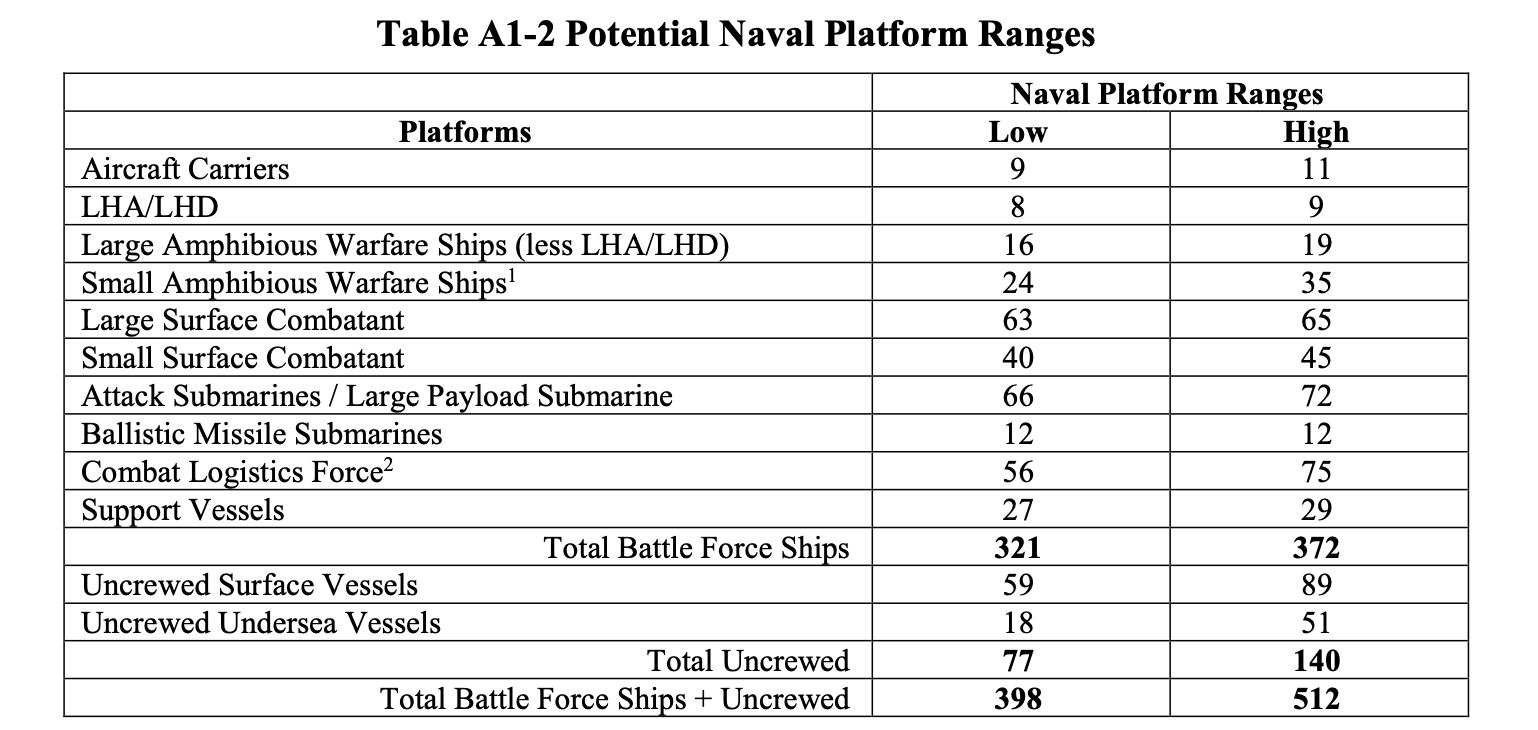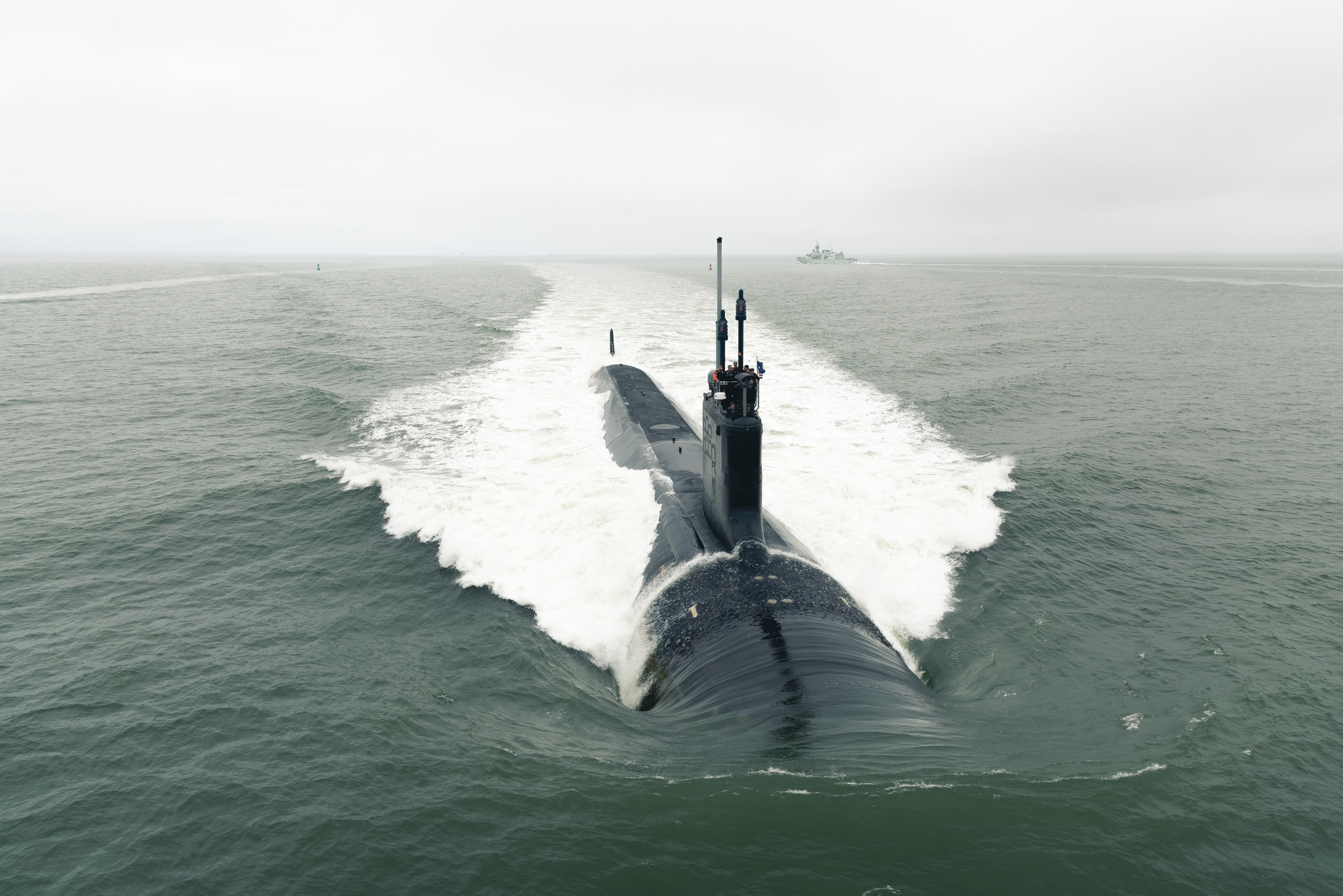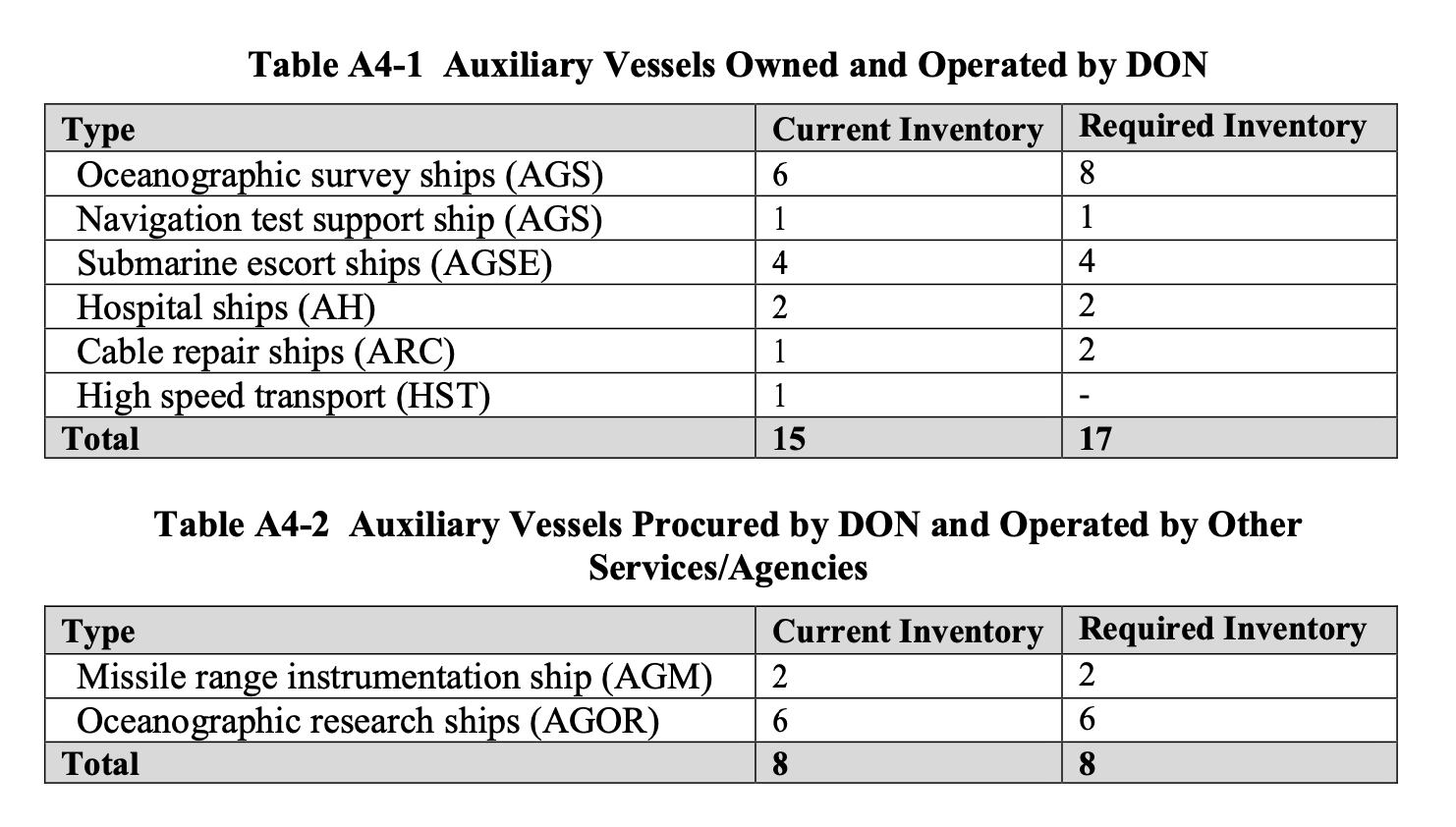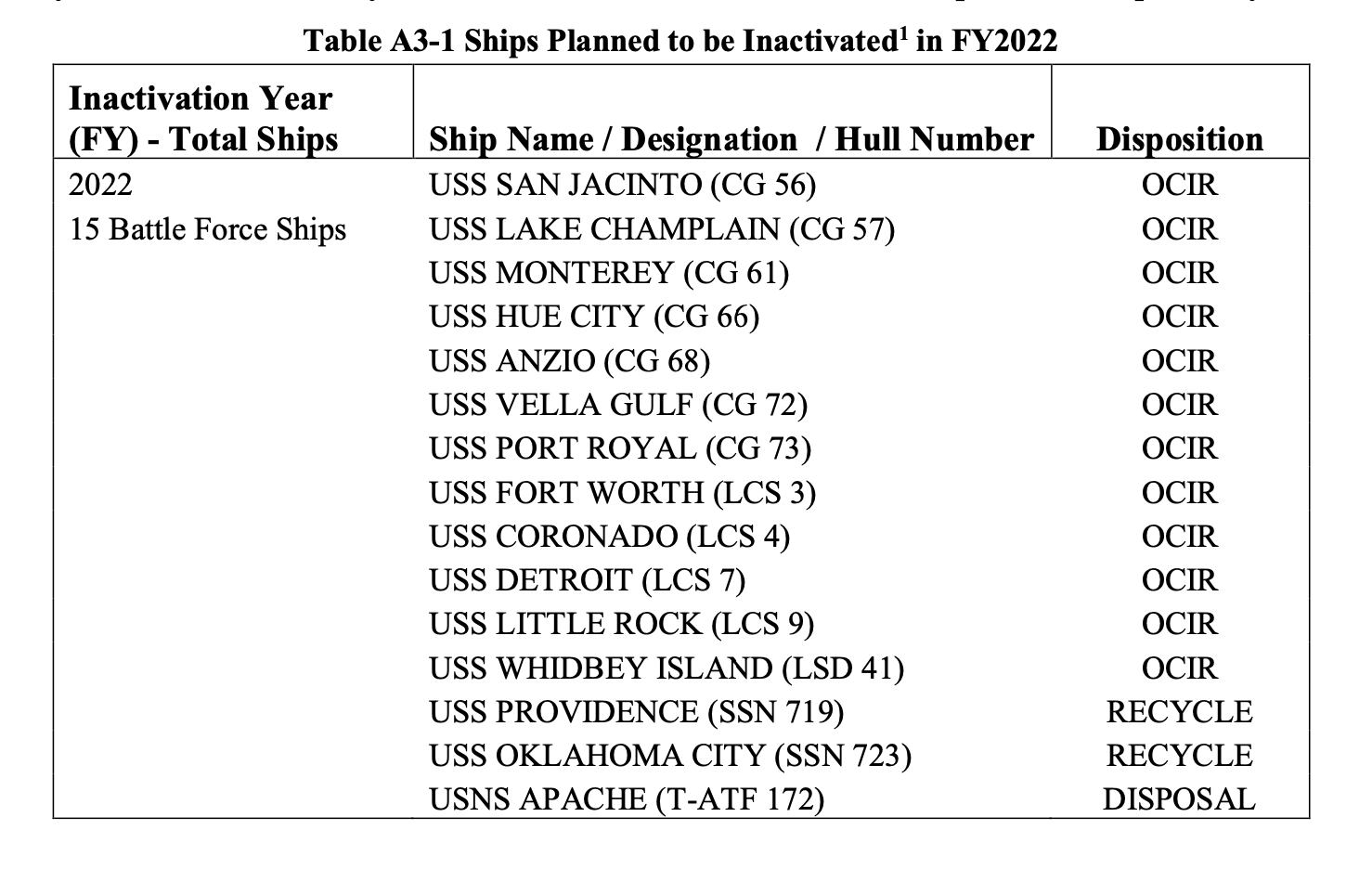WASHINGTON – The Navy submitted an update to Congress to its annual long-range shipbuilding plans, one that takes a step back from the much-talked-about standard of a 355-ship fleet and instead lays out priorities for a future distributed naval force.
The new document lays out a manned fleet as low as 321 manned ships and potentially as large as 372 manned ships.
A fleet of 321 manned ships would be a departure from past modeling, wargaming and analysis that pointed to a fleet of 355 or more manned ships to counter threats from China and Russia in a future fight. The lower number, though, is more in line with current fiscal constraints and industry capacity. Chief of Naval Operations Adm. Mike Gilday said this week that, “based on the top-line that we have, that we can afford a Navy of about 300 ships” – and there’s not much hope that Navy shipbuilding budgets will increase drastically in the next few years.
Those 321 to 372 manned ships would be supplemented by a yet-to-be-determined number of unmanned surface and underwater vessels – between 77 and 140, according to the document. It notes that new types of platforms, such as unmanned vessels, “bring great potential, but also have greater developmental risk. This is represented by a wider objective range. As prototyping and experimentation retire technical and [concept of operations] uncertainty and risk, along with a clearer understanding of the associated costs, we expect that the objective force ranges will narrow.”
As a result, the Navy’s total fleet could range from 398 manned and unmanned ships to 512. The document, obtained by Defense News June 17, states the Navy will release a more detailed long-range plan with the FY23 budget request next year.
“In the interim, the Department will continue to build on ongoing analysis, experimentation, testing, prototyping, and the analytic results from force structure assessments, future fleet architectures, and intelligence updates to refine required capabilities and characterize the technical and operational risk of an objective battle force in military competition. This work will inform the content and transition pace to the future force and be reflected in the FY2023 shipbuilding plan.”

Defense Secretary Lloyd Austin in a June 17 hearing called 355 ships “a good goal to shoot for” but said he was working to field “the right mix of capabilities. Size matters, but capabilities also matter.”
The Navy is required to submit a 30-year shipbuilding plan to Congress each year along with its budget request, but the document is often skipped in the first year of a new presidential administration. The outgoing Trump administration submitted a document in December 2020 that was labeled a fiscal 2022 long-range ship plan, and it laid out a fleet that would grow to 347 manned ships by the end of the decade and above 400 manned ships by 2050. The Biden administration has accompanied its FY22 budget request with a shorter document that includes more themes and priorities than actual long-range shipbuilding and ship inventory projections.

The document maintains the Navy’s focus on undersea warfare, which leadership has repeatedly said is an advantage the Navy needs to protect and expand. Still, it notes that the Navy and industry wouldn’t dramatically expand the size of the attack submarine fleet before the late 2030s, when the Columbia-class ballistic missile submarine procurement ends.
“Maintaining the undersea advantage is a priority for the Navy. As the Navy’s most survivable strike platforms, SSNs and SSBNs are key to both deterrence and winning conflict against a rival power. To meet the demand for additional submarines, industrial base capacity must be expanded. The plan beyond the Future Year Defense Program (FYDP) reflects an increase in SSN production that is fully realized with the conclusion of the Columbia class procurement and delivery. We continue to evaluate the industrial base capacity increase required for more consistent delivery of two SSNs per year during Columbia serial production and subsequent potential increases to SSN procurement.”
The document maintains the service’s commitment to fielding small surface combatants in greater numbers, freeing up a smaller fleet of large surface combatants to conduct only the most complex missions with their larger sensors and weapons. It also continues support for nuclear-powered aircraft carriers but notes that “new capability concepts like a light aircraft carrier continue to be studied and analyzed to fully illuminate their potential to execute key mission elements in a more distributed manner and to inform the best mix of a future force.”
And it acknowledges that the Marine Corps’ Force Design 2030 effort that is overhauling the Fleet Marine Force has implications for shipbuilding as well. “This approach requires a new mix of amphibious warships (LHA/LPD) and includes the Light Amphibious Warship (LAW), which is an enabler of [Marine Littoral Regiment] mobility and sustainability. The overall number of amphibious warships grows to support the more distributed expeditionary force design, with LAWs complementing a smaller number of traditional amphibious warships.”
Generally, it notes, “the concepts of Distributed Maritime Operations (DMO) and Littoral Operations in a Contested Environment (LOCE) / Expeditionary Advanced Base Operations (EABO) require a balanced and different mix of traditional battle force ships and new amphibious and logistic ships. This will result in greater combat power than previous force structures in addition to new and key roles played by uncrewed platforms. These concepts and capabilities are being analyzed, tested, experimented, and exercised to better define a future objective battle force.”

The document also outlines sealift and auxiliary ship gaps the service faces.
The Navy is short two oceanographic survey ships – and plans to buy two in FY22 – and one cable repair ship.
On organic strategic sealift, the Navy has a shortfall of roll-on/roll-off (RORO) cargo vehicle ships, with just 35 in the inventory today compared to a requirement for 53.
The document states the Navy’s FY22 spending request “continues Navy’s commitment to surge sealift requirements through procurement of used vessels to replace aging surge sealift capacity and conversion/upgrade of all newly-procured used RORO vessels to be performed in U.S. shipyards in a profile closely aligned to the procurement schedule. The recapitalization plan also includes adjustments to the existing fleet with service life extension of the ten most viable platforms, retirement of the seven least-ready roll-on/roll-off vessels, retirement of four special mission ships, continued investment in platform maintenance, and consolidation of the Surge Sealift and Ready Reserve Force.”
The Navy is seeking $369 million to buy five used RORO ships.

The document also lays out planned ship decommissionings in FY22, which has already been a point of contention between the Navy and lawmakers.
The service would decommission seven cruisers – five that were already planned to age out of the fleet, and two more that are partway through a modernization program that’s growing more costly and more timely; four Littoral Combat Ships, two of which Congress said no to decommissioning in FY21; an amphibious dock landing ship, two attack submarines and a fleet tug.
Lawmakers on both sides of the aisle criticized the Navy in a June 15 hearing with the full House Armed Services Committee and a June 17 HASC Seapower and Projection Forces Subcommittee hearing, arguing the Navy should have released a full five-year plan and a 30-year shipbuilding plan with its FY22 budget request in accordance with the law. The Navy released its plan on the evening of June 17, hours after the subcommittee hearing, but it didn’t sit well with all lawmakers.
“The law requires a 30-year shipbuilding plan and a future years defense plan (FYDP). Neither has been provided by the Pentagon. If the Navy does not give Congress a plan, we can’t tell where they are going — we have to make assumptions. If we assume that next year’s budget will also fail to enable the force structure that we need, we will be forced to make broad cuts to other programs to fund the force structure that the Navy cannot articulate themselves. When the Navy provides ranges of ships needed it is clear that they do not have a strategy that defines actual requirements, otherwise it would be a discrete and defensible number,” said Rep. Elaine Luria, D-Va., who sits on the subcommittee and serves as vice chair of the full committee.
Megan Eckstein is the naval warfare reporter at Defense News. She has covered military news since 2009, with a focus on U.S. Navy and Marine Corps operations, acquisition programs and budgets. She has reported from four geographic fleets and is happiest when she’s filing stories from a ship. Megan is a University of Maryland alumna.




